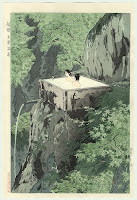
I started appreciating Japanese prints years ago when I toured the Freer Gallery at the Smithsonian and saw a collection of Hokusai's 36 Views of Mt. Fuji or maybe it was Journeys to the Waterfalls in all the Provinces. I don't remember right now.
For good measure, even though this entry is about Hasui Kawase, here is one Hokusai waterfall.
Sometime later, my grandmother gave me an antique bijin print (beautiful woman), which is pictured in my first entry on this blog.
All this led to my purchasing a series of Japanese woodblock print calendar
s for several years running. They all featured an artist I didn't know, since I'd mainly looked at older Japanese prints of the ukiyo-e type (pictures of the floating world, a reference to geishas, entertainments, etc.). These were by Hasui Kawase, who
m I've since learned was the leading artist of the Shin Hanga school in the 20
th century. Shin Hange, "New Prints", was seen as a revival of the ukiyo-e approach. (Of which, another time.) Kawase was named a "national treasure" of Japan for his work.
These prints in these calendars captured me, and one day, Lisa asked me which within one calendar were my favorite. And for Valentine's Day of the next year, she presented me with those favorite calendar pages matted and framed. I have
6 of them in our computer room. Here is one, in a somewhat blurry iPhone pic:
They are handsome
, even as calendar pics, so I always wanted to know what they would be like "for real."
For real, with a woodblock print, is:
> Printed on rice paper using a series of carved woodblocks
> Preferably using good condition the original blocks, since the blocks can wear out and would be re-carved. And as blocks wore out, printers would sometimes compensate for the loss of line and subtlety through the emphasis of bolder colors.
> Preferably from during the artist's lifetime, on the assumption he would have overseen the wor
k enough to ensure it's quality.
> And preferably from the first run of prints, or as ear
ly as possible.
For Hasui, prints that meet all those conditions and are in good condition might cost thousands. The Hokusai above, being older, rarer and of an international level of art would be auctioned off at Christies and housed in museums.
But.
You can buy a genuine Hasui from the original blocks on rice paper for about $250. The condition is pristine; it just isn't from the artist's lifetime. I've now purchased two. The first is at the framer now, and the second just arrived by FedEx! It's for Lisa for Christmas, so don't let her know.
Kiyomizu Temple, Kyoto, 1933
There's a delightful comparison of prints of this temple by various Japanese artists on the
Artlino site.
In the next picture, our new print, Honmonji Temple, is s
et side by side with Hasui's original sketch. To make the w
ood blocks, the artist's drawing is laid on top of a cherry block and the carver executes the drawing on the wood.
Now the problem is where to put them in our house!














